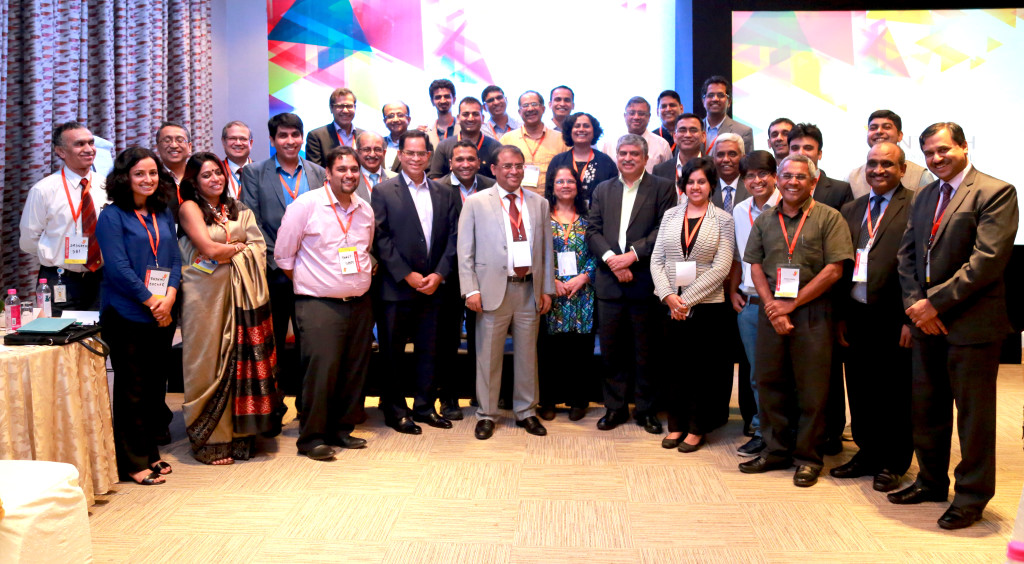At iSPIRT, our belief is that banking will change more in the next five years than it has in the last 50 years. For a variety of reasons, the changes happening in India will follow a path that is very different from other countries. Indian Banks therefore have two choices: Create a new playbook to deal with these changes, or stick to the old rulebook and risk being disrupted.
In mid-2015, Nandan Nilekani gave a talk titled, The Whatsapp Moment in Banking that went viral within banking circles. The analogy was derived from the manner in which the sharp growth of Whatsapp had hit the SMS revenues of the global telecom industry. SMS used to account for 10-15 percent of the global telco industry revenues but Whatsapp, a company that had a mere 40 people in 2009 easily eclipsed them with a traffic of 30 billion messages per day. As against this, all the incumbent telcos of the world put together accounted for just 20 million messages per day! Similarly, a growing confluence of technologies would allow new age banks to handle millions of customers at a very low cost, without costly branches and expensive technologies; and with a minimum staff strength.
Responding to this challenge, Mrs. Arundhati Bhattacharya, the Chairman of the State Bank of India, India’s largest bank, brought a team of more than 30 senior leaders from SBI to Bangalore for a half-day session on how banking is being transformed in July 2015. This session became the forerunner for a forum called the FinTech Leapfrog Council (FTLC) that iSPIRT set up to help incumbent banks navigate the disruptive changes facing them.
 For incumbent banks to transform themselves is a truly difficult challenge, but given that these banks cumulatively account for more than 30 percent of the Indian banking sector, their transformation is of national importance. In the first phase of FTLC, four banks — SBI, Bank of Baroda, Axis Bank and IDFC Bank — were invited to join FTLC, and all four of them accepted. FTLC then helped the banks through quarterly workshops that consisted of deep-dives focused on disruptions in areas like alternative lending, payments and analytics; and emerging technologies like the Unified Payment Interface, and the IndiaStack, which enables cashless, presenceless and paperless transactions with a consent layer on top. Some of the industry leaders who spoke at FTLC workshops, which attracts the CEOs and top management of the four banks are:
For incumbent banks to transform themselves is a truly difficult challenge, but given that these banks cumulatively account for more than 30 percent of the Indian banking sector, their transformation is of national importance. In the first phase of FTLC, four banks — SBI, Bank of Baroda, Axis Bank and IDFC Bank — were invited to join FTLC, and all four of them accepted. FTLC then helped the banks through quarterly workshops that consisted of deep-dives focused on disruptions in areas like alternative lending, payments and analytics; and emerging technologies like the Unified Payment Interface, and the IndiaStack, which enables cashless, presenceless and paperless transactions with a consent layer on top. Some of the industry leaders who spoke at FTLC workshops, which attracts the CEOs and top management of the four banks are:
- Shamir Karkal, Head of Open APIs at BBVA Bank, Spain, and co-founder of Simple Bank
- S Ramakrishnan, former Chief Data Officer of Citibank
- Prof. Saras Sarasvathy of the Darden School of Business
- Nandan Nilekani
- Sharad Sharma, co-founder of iSPIRT
- Sanjay Swamy, Managing Partner of Prime Ventures.
While everyone agrees that what a bank looks like 5-10 years from now would be radically different, no one can predict exactly what the bank of the future will look like. In this situation, banks face one of the most disconcerting forms of change that we call non-linear change. In the FTLC taxonomy, there are three kinds of change:
- Incremental change focussed on process improvement — for example, approving a loan in five days as opposed to seven days
- Disruptive change which is very painful, but where the end state is well known. Several MNC IT services companies faced this, when they recognized that they had to embrace the Global Delivery Model perfected by Indian services companies. In the last few years, many of these MNCs turned around their business models and reached a point where most of their employees are in India. The change was painful, but they had a sense of where they were and where they need to be.
- Non-Linear Change, where the end state is difficult to predict. In the telecom industry, who would have predicted that Whatsapp would carry 30 billion messages a day? In the transport industry, who would have predicted that Uber, a company founded in March 2009, would be valued at $62.5 billion in June 2015?
To navigate the Non Linear Change, iSPIRT helped the FTLC banks embrace Non Predictive Control (NPC), a method researched by Prof. Saras Sarasvathy of the Darden School of Business. While strategic planning helps organizations in situations where the future is predictable, NPC helps banks in situations where the future is unpredictable. For instance, its is clear that a large expansion will take place in non-collateralized debt to the underbanked, but it is impossible to know what this alternative lending system will exactly look like. Hence, it’s imperative that banks bet on several competing scenarios, monitor progress on all of them, and then retire or double down on each bet. iSPIRT curated a set of startups in Alternative Lending and Payments, and set up several pilots with the FTLC banks, to help them master the NPC methodology.
For Indian banks, another development, unique to our country, is the emergence of the IndiaStack, a powerful set of Open APIs to enable cashless, presence less and paperless transactions with a consent layer that empowers users with control over their data. iSPIRT has been closely involved in the development of the IndiaStack, which rides on top of the JAM trinity consisting of JanDhan bank accounts, Aadhaar biometric identification and Mobilephones.
The Government promoting financial inclusion through Jhan Dhan Yojana, has led to over 263 million new bank accounts being opened. With RBI giving licences to over 20 new banks, including small banks and payment banks, the competitive intensity of the sector is set to increase. Over 1 billion Indian residents now have Aadhaar, an online biometric identity, and smartphones are expected to reach a penetration of 700 million by 2020. One can visualise a future where every adult Indian has an Aadhaar number, a smartphone and a bank account. Already over 367 million Indian residents have an Aadhaar linked bank account and more than 1 billion DBT (Direct Benefit Transfer) transactions have happened, whose value is in the billions of dollars. Those banks that leverage the JAM trinity and the India Stack will be able to reach out to a vast new set of customers, at a dramatically lower cost. For example, it is estimated that the cost of complying with the mandatory Know Your Customer (KYC) norms can be brought down from Rs 1,000 to Rs 5, by using the IndiaStack. This alone can enable the process of financial inclusion for millions of Indians.
Industry experts, like Bill Gates, and many others who have been following these developments, feel that India is set to leapfrog the rest of the world in financial inclusion. The FTLC program combines global best practices with a home-grown, world-class architecture for financial inclusion, and helps incumbent Indian banks create a “leapfrog roadmap” for their organizations.



 For incumbent banks to transform themselves is a truly difficult challenge, but given that these banks cumulatively account for more than 30 percent of the Indian banking sector, their transformation is of national importance. In the first phase of FTLC, four banks — SBI, Bank of Baroda, Axis Bank and IDFC Bank — were invited to join FTLC, and all four of them accepted. FTLC then helped the banks through quarterly workshops that consisted of deep-dives focused on disruptions in areas like alternative lending, payments and analytics; and emerging technologies like the Unified Payment Interface, and the
For incumbent banks to transform themselves is a truly difficult challenge, but given that these banks cumulatively account for more than 30 percent of the Indian banking sector, their transformation is of national importance. In the first phase of FTLC, four banks — SBI, Bank of Baroda, Axis Bank and IDFC Bank — were invited to join FTLC, and all four of them accepted. FTLC then helped the banks through quarterly workshops that consisted of deep-dives focused on disruptions in areas like alternative lending, payments and analytics; and emerging technologies like the Unified Payment Interface, and the